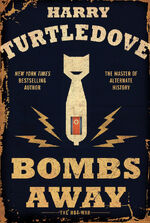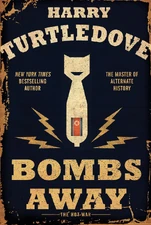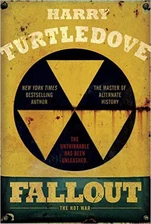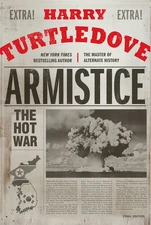| Bombs Away | |
|---|---|
 | |
| Author | Harry Turtledove |
| Cover artist | Dmitri Ezepov |
| Publisher | Del Rey |
| Publication date | July 14, 2015 |
| Followed by | Fallout |
Bombs Away is the first volume of a projected alternate history series, The Hot War, in which atomic weapons are used during the Korean War, leading to the outbreak of World War III. It was released on July 14, 2015.[1]
The novel begins on November 23, 1950, after Chinese forces have intervened in the Korean War. In OTL, Chinese troops were able to encircle UN forces at the Battle of Chosin, but the UN forces were able to break out and evacuate North Korea in good order. In Bombs Away, the Chinese appear to have been much more aggressive early on, with the result that about three UN divisions are encircled and systematically destroyed over the closing weeks of November and into December, despite U.S. efforts to provide air support. In response, on December 18, 1950, during a conference with General Douglas MacArthur, President Harry Truman authorizes MacArthur to use atomic bombs against China proper if it is the only way to improve the situation. While Truman has concerns about the Joseph Stalin's reaction should his allies in China be attacked, MacArthur's assurances that Stalin will not react, coupled with the heavy cost China's intervention has already exacted against the U.S., convinces Truman to give the go-ahead.
The U.S. launches its attack in Manchuria on January 23, 1951. On February 1, the Soviet Union attacks Britain, France, and West Germany. As the first two are members of NATO, the U.S. and other NATO signatories are required to treat these attacks as an attack on all members. For the next several weeks, the U.S. and the USSR tit-for-tat bomb strategic possessions in their respective territories, including attacks in various Soviet satellites, until the USSR and those satellites, including East Germany, Poland, Hungary, and Czechoslovakia, launch an invasion into West Germany, Austria, and Italy, thus beginning World War III.
On March 2, 1951, the Soviets are able to stage daring atomic attacks along the entire U.S. west coast and interior, hitting Seattle, Portland, San Francisco, Los Angeles, Salt Lake City, and Denver. The Soviets also attack Bangor, Maine and a location in Newfoundland. Spokane and Las Vegas (or possibly Hoover Dam) are also targeted but the Soviet bombers assigned to these cities are shot down by American air defenses.
In response, the United States launches a full scale nuclear attack on the Soviet Union; On March 4, 1951, American bombers, despite taking heavy losses, destroy the eastern cities of Vladivostok, Yuzhno-Sakhalinsk, Magadan, Petropavlovsk-Kamchatsky and Provideniya with atomic bombs. Subsequently, the Americans attack the Soviet Union's largest urban areas, destroying Leningrad (which is hit with at least two nuclear bombs), Kiev, Minsk and a number of other cities in the west. In mid-March 1951, the Americans attempt to decapitate the Soviet leadership, hitting Moscow with three atomic bombs, which devastate the city while vaporizing the Kremlin and the Lubyanka. Although many commissars and generals are killed in these attacks, Stalin manages to escape to Kuibishev where he continues overseeing the war effort.
In the meantime, the land war in Europe is initially successful for the Soviets, as they overrun Austria, and push into northern Italy. Allied forces in West Germany are in a constant state of retreat throughout the spring and into summer. However, the United States decides, at least for now, to honor the wishes of Konrad Adenauer, who literally begs Truman not to use Nuclear weapons over West Germany, warning him that doing so will likely turn the German people against the allies. The United States also decides not to target the major cities of Eastern Europe, as Truman hopes that the war will eventually lead to rebellions within the Soviet satellite states.
After the initial bombing raids against the U.S., the Soviets are forced to use their considerably smaller nuclear arsenal more sparingly. In April 1951, the Soviet Union detonates bombs in the Panama and Suez Canals and launch a nuclear strike against the city Bordeaux, but use conventional explosives against air fields in Britain. The United States responds by stepping up its nuclear campaign against the Soviet Union. In one attack launched in May 1951, American nuclear strikes destroy the cities of Khabarovsk and Blagoveshchensk, inflicting further damage to the Trans-Siberian railroad.
With neither side willing to back down, and with the looming development of far more powerful Thermonuclear weapons, civilians, soldiers and politicians on both sides wonder how much, if any, of the world will be left by the time the war ends.
The novel ends with the U.S. military efforts in Western Europe in dire straits, as the Red Army continues to advance through West Germany and towards the French border, despite taking heavy losses. For the Soviets, critical damage to the Trans-Siberian railroad system and the destruction of almost all of their major cities (with the Americans targeting even more cities as the war continues) hampers Soviet war efforts as their economy and infrastructure are strained to the breaking point. The Korean War has became a sideshow, with both sides having their supply-lines heavily damaged. In June 1951, on the final page of the book, the Soviets drop an atom bomb in Paris.
References
| |||||||||||||||||||||


